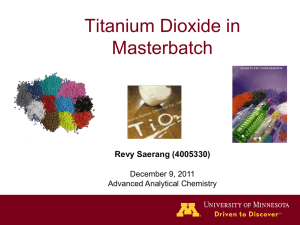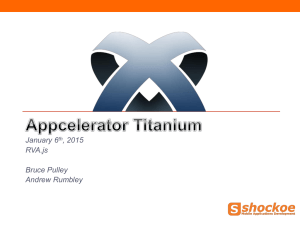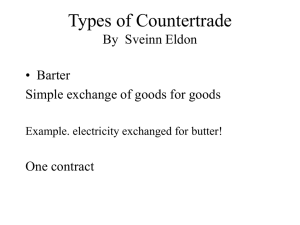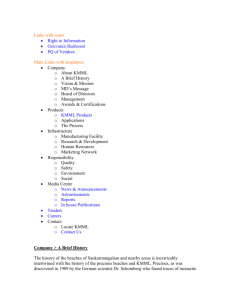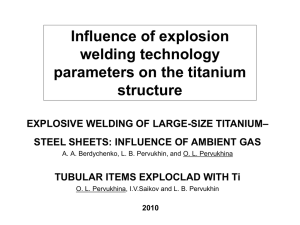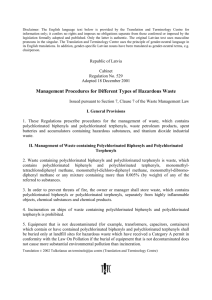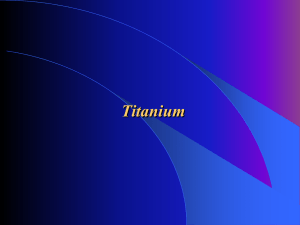Titanium Dioxide in Masterbatch
advertisement
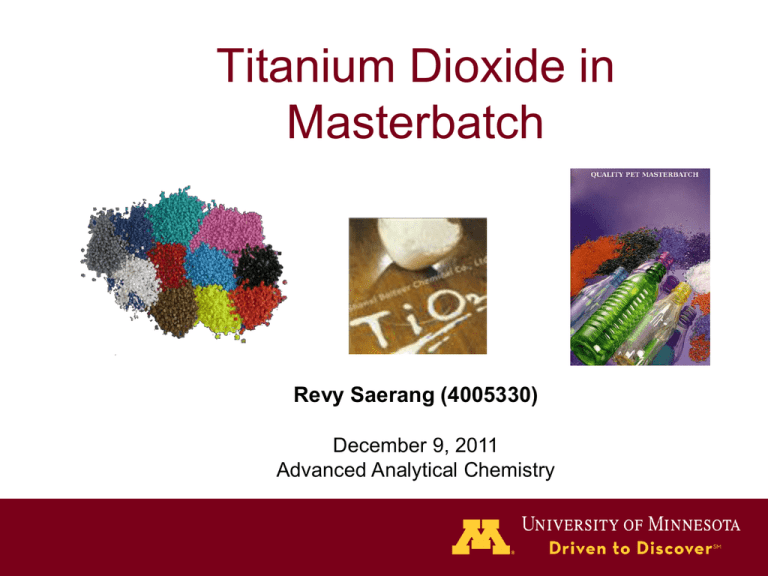
Titanium Dioxide in Masterbatch Revy Saerang (4005330) December 9, 2011 Advanced Analytical Chemistry Buzzword: Masterbatch What is it? • Color-pigmented material for plastic industry – Packaging (Food, beverage, cosmetic), computer hardware, automotive parts, etc. Use to insert colors and impart special properties to plastic products. • 1-2 % contribution in cost of production but master batch drives the quality, durability of the plastic product.1 1//www.clariant.com/C125766B004CDFBC/vwWebPagesByID/04872E207B80A989C12568CE003E269A (accessed on November 29, 2011) Masterbatch Process Problem • Titanium Dioxide – Titanium id a refractory metal2. – Inorganic nanoparticle that is used extensively in masterbatch production as a white pigment, opacifier for colored systems and UV stability agent. – Incorporated with additives, resins in colored masterbatch production. • Titanium Dioxide in Masterbatch industry – Titanium dioxide is a central ingredient to imparting clean, bright whites, or fine tuning the shades of color for the right eye appeal 2. – The actual amount and particle size of TiO2 will affect the shades of the right appeal due to changes in its scattering efficiency, photocatalytic effect 3. – Reformulation and remixing need to be done when the batch production does not meet the right appeal or specification and this affects cost of manufacturing, production schedule, customers’ satisfaction. 2 www2.dupont.com/Titanium_Technologies/en_US/products/104/R104_Intro_Brochure.pdf Accesed on (Nov 29, 2011) 3Fisher, J. and Egerton, T.A.2001. Titanium Compounds, Inorganic. Kirk-Othmer Encyclopedia of Chemical Technology Hypothesis • Hypothesis – The actual content and the particle size of titanium dioxide (pigment) in masterbatch formulation in comparison to other components (oxidant reagent, wax, resin) has lead to nonhomogeneity of mixing and to cause a hindrance of pigments to perform optimized coloration and pigmentation. Possible Analytical Methods Analytical Methods Advantages Disadvantages Size Exclusion Chromatography Good separation of large and small molecule, good sensitivity It is normally combined with other characteristics (acidity, charge), limited number of bands ICP-MS Easy sample introduction, quick analysis, low detection limit, accurate, capable of trace at part per trillion level Expensive, interferences from plasma gas, matrix effects X-ray Fluorescence Spectrometry5 High precision, determine major element, detect several thousands atoms Expensive, space limitation on sample, high scattering, low detecting intensities 5 Potts, P.J and Webb.P.C. X-ray Fluorescence Spectrometry [Online]. In: G.E.M Hall (Editor). Geoananalysis. J. Geochem. Explor., 44:251-296 ICP-MS Sample diluted in HNO3 • The sample is nebulized using a method of slurry nebulization into a the inductively coupled plasma, and a fine mist is created as high velocity argon, then in hot plasma the fine droplets are atomized then ionized. Sample ions are passed into MS system at vacuum using quadrapole mass filter where the ion will be observed at a specific m/z ratio at a vacuum chamber Sample Preparation4 • Collect sample powder and dilute with nitric acid to give required acid concentration and add distilled water to adjust volume. • Add 0.01% (m/v) of PVA (Poly Vinyl Alcohol) as a dispersion agent and stabilizer • In a beaker, use magnetic stirrer and stir for 10 minutes to ensure homogenization before it is nebulized. • Use an ultrasonicator and shake the flask vigorously for around 30 minutes prior to analysis 4Guoqiang X, Bin H, Zucheng J and Chuqing. A comparison of slurry sampling electrothermal vaporization and slurry nebulization inductively coupled plasma mass spectrometry for the direct determination of trace impurities in titanium dioxide powder. Journal of Mass Spectrometry. 2006:41B:1378-1385 Experimental Procedure • Determine masterbatch productions for ones that always need reformulation in QC lab. • Disperse sample in an acidic medium, followed by direct nebulization of suspension into the ICP. • Determine how much is the actual content of titanium dioxide using a quantitative technique. • Obtain calibration curve for standards for these above productions using a similar procedure listed above by ranging the actual content of TiO2 and particle sizes. – Use this to analyze the current productions and to take measures on what should be done for future production. Results • When using aqueous solution in SN-ICP-MS, the mean particle is the most important for the analytical accuracy. Under optimized ICP-MS condition the result show that maximum scattering visible light (400-700 nm) light occurs for pigment particles of 300 nm and the scattering efficiency decreases rapidly as the particle size varies6. Mass spectrometry determines the actual content of titanium dioxide in masterbatch production can be quantified and this is significant in optimizing the formulation of masterbatch production 6 Fisher, J. and Egerton, T. A. 2001. Titanium Compounds, Inorganic. Kirk-Othmer Encyclopedia of Chemical Technology Conclusion • Best separation technique is Slurry NebulizationInductively Coupled Plasma-Mass spectrometry (SNICP-MS). – Quantify the actual content of Titanium Dioxide and recognize the particle size effect. • Particle size of titanium dioxide and the actual content of titanium dioxide in one formulation of masterbatch production is significantly important in determining the right shade of color appeal due to its photocatalytic effect, scattering efficiency, and other optical properties. References 1. 2. 3. 4. 5. 6. 7. Clariant Corp. Masterbatches Profile. 2011 <//www.clariant.com/C125766B004CDFBC/vwWebPagesByID/04872E207B80A989C12568CE003E269A> (accessed on November 29, 2011) Dupont. DupontTM Ti-Pure R-104 titanium dioxide. <www2.dupont.com/Titanium_Technologies/en_US/products/104/R104_Intro_Brochure.pdf > Accesed on (Nov 29, 2011) Fisher, J. and Egerton, T.A.2001. Titanium Compounds, Inorganic. Kirk-Othmer Encyclopedia of Chemical Technology Guoqiang X, Bin H, Zucheng J and Chuqing. A comparison of slurry sampling electrothermal vaporization and slurry nebulization inductively coupled plasma mass spectrometry for the direct determination of trace impurities in titanium dioxide powder. Journal of Mass Spectrometry. 2006:41B:1378-1385 Potts, P.J and Webb.P.C. X-ray Fluorescence Spectrometry [Online]. In: G.E.M Hall (Editor). Geoananalysis. J. Geochem. Explor., 44:251-296 Fisher, J. and Egerton, T. A. 2001. Titanium Compounds, Inorganic. Kirk-Othmer Encyclopedia of Chemical Technology Skoog, D.; Holler, F.; Crouch, S. Principles of Instrumental Analysis, 6th ed
